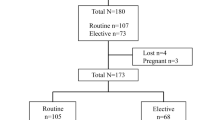Abstract
Purpose
To evaluate the effect of Morgagni hydatid (MH) on infertility by comparing women known to be fertile and infertile with respect to MH frequency.
Methods
The study was conducted in Gaziantep University Faculty of Medicine with the precipitation of total 455 patients. The 240 of them were pregnant to whom planned cesarean section (C/S) and the other 215 were infertile one who have undergone diagnostic laparoscopy. Fertile Group (Group 1) consisted of women whom have become spontaneously pregnant without any kind of infertility management. These are planned to undergo C/S with different indications. Infertile group (Group 2) consisted of women diagnosed as unexplained infertility and planned to undergo diagnostic laparoscopy according to ASRM 2006 guidelines. The frequency, number, and the bilaterality of the MH were evaluated during the C/S in fertile group and diagnostic laparoscopy in infertile group. SPSS was used for statistical analyses.
Results
The MH frequency was higher in Group 2 than Group 1 (P < 0.05). The bilaterality of MHs were significantly higher in Group 2 than Group 1 (P < 0.05).The number of the MHs were significantly higher in Group 2 than Group 1 (P < 0.05).
Conclusions
These findings suggest a possible effect of MH on fertility. The theory of MH disturbing tubal motility with respect to the pick-up and transport of ovum appears logical in this aspect.
Similar content being viewed by others
References
The Practice Committee of the American Society for Reproductive Medicine (2006) Effectiveness and treatment for unexplained infertility. Fertil Steril 86:111–114
Perlman S, Hertweck P, Fallat ME (2005) Paratubal and tubal abnormalities. Semin Pediatr Surg 14:124–134
Wittich AC (2002) Hydatid of Morgagni with torsion diagnosed during cesarean delivery: a case report. J Reprod Med 47:680–682
Rizk DE, Lakshminarasimha B, Joshi S (2002) Torsion of the fallopian tube in an adolescent female: a case report. J Pediatr Adolesc Gynecol 15:159–161
Dieminger HJ, Friebel L, Bethmann R (1985) Primary cancer of a Morgagni hydatid. Zentralbl Gynakol 107:442–445
The Practice Committee of the American Society for Reproductive Medicine (2006) Optimal evaluation of the infertile female. Fertil Steril 86:264–267
Sunoo CS, Terada KY, Kamemoto LE, Hale RW (1990) Adnexal masses in pregnancy: occurrence by ethnic group. Obstet Gynecol 75:38–40
Pansky M, Smorgick N, Lotan G, Herman A, Schneider D, Halperin R (2006) Adnexal torsion involving hydatids of Morgagni: a rare cause of acute abdominal pain in adolescents. Obstet Gynecol 108:100–102
Conflict of interest statement
None.
Author information
Authors and Affiliations
Corresponding author
Rights and permissions
About this article
Cite this article
Cebesoy, F.B., Kutlar, I., Dikensoy, E. et al. Morgagni hydatids: a new factor in infertility?. Arch Gynecol Obstet 281, 1015–1017 (2010). https://doi.org/10.1007/s00404-009-1233-7
Received:
Accepted:
Published:
Issue Date:
DOI: https://doi.org/10.1007/s00404-009-1233-7




